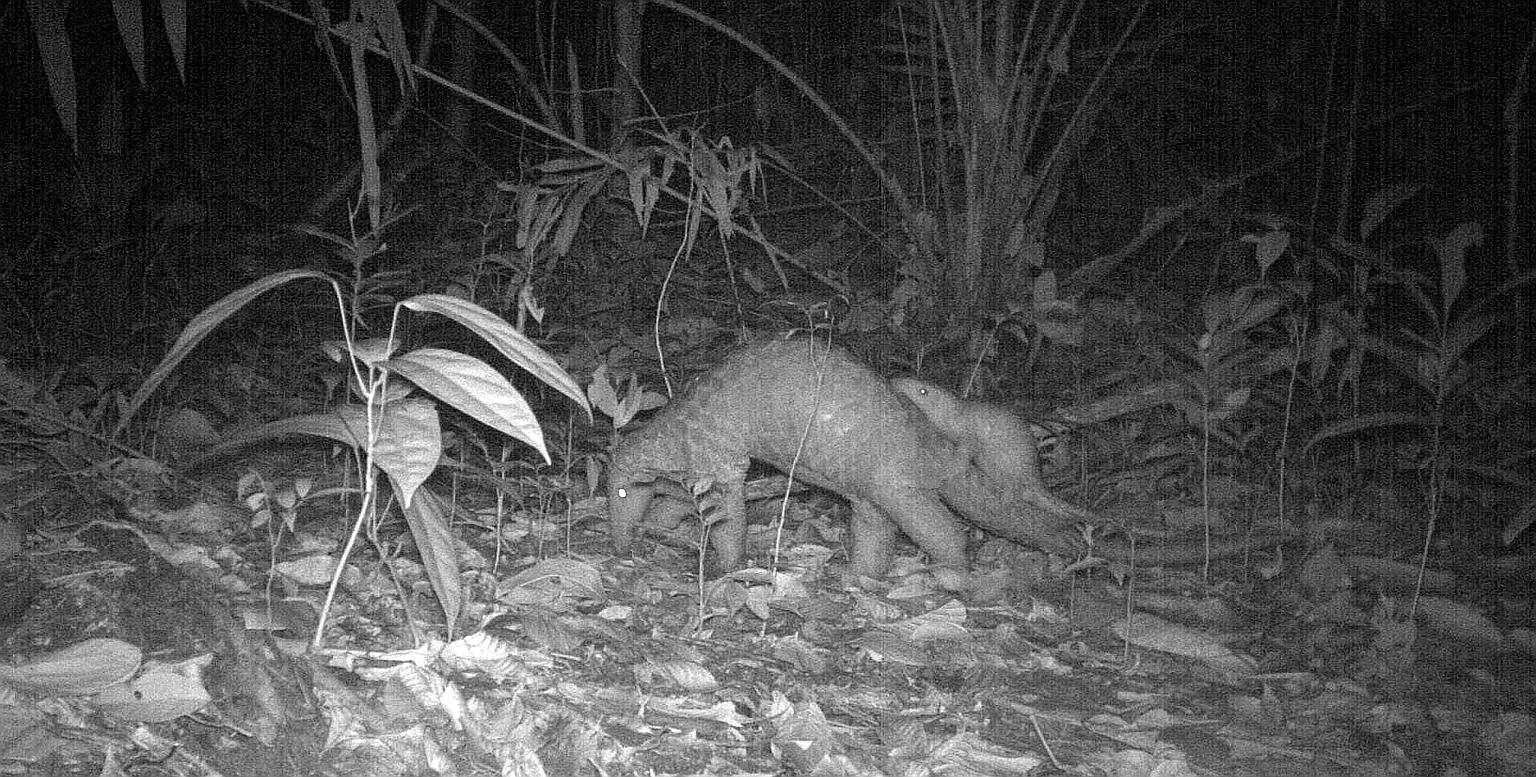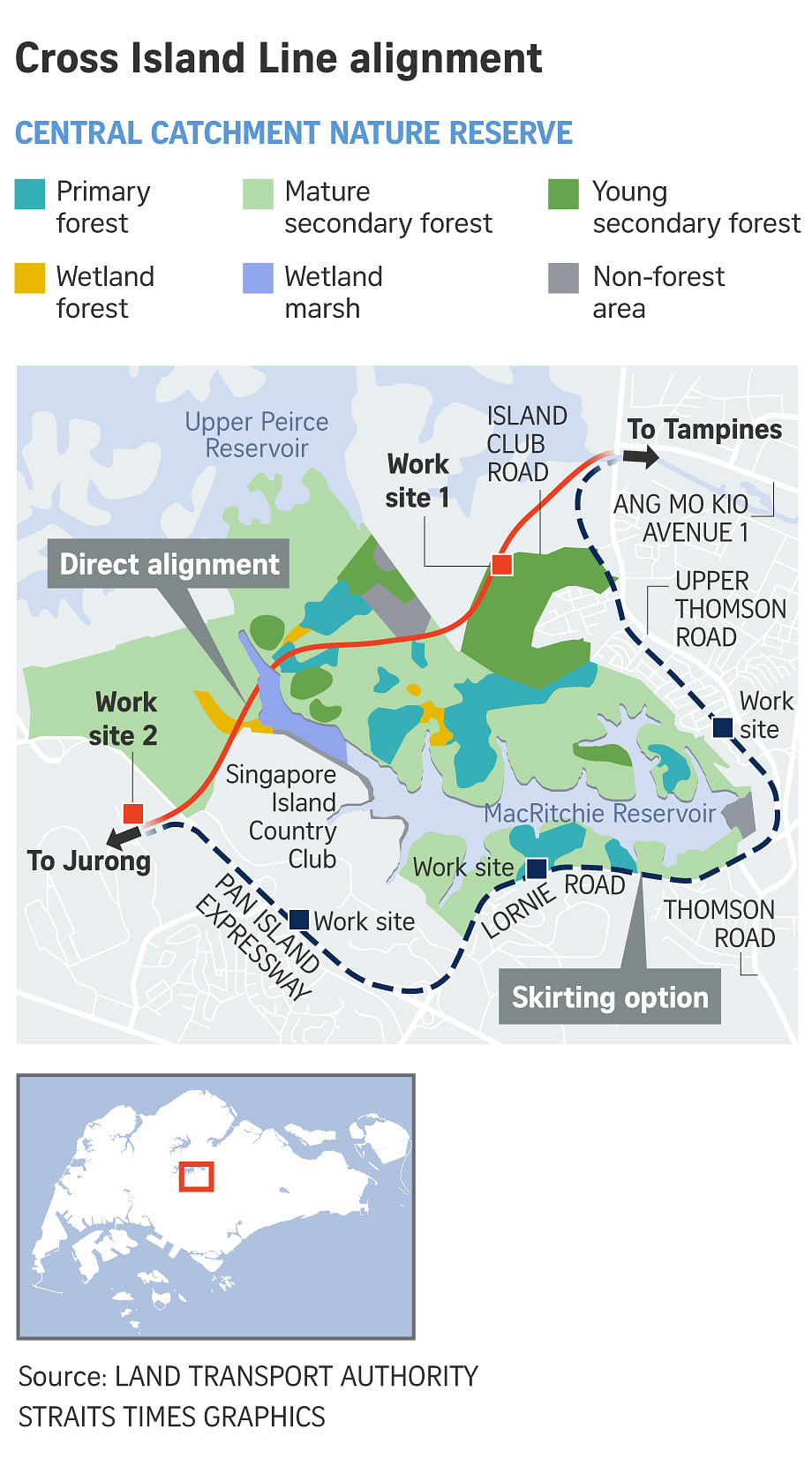Cross Island Line: Concerns about wildlife linger despite plans to reduce impact
Sign up now: Get ST's newsletters delivered to your inbox

A Sunda pangolin mother and juvenile spotted near Sime Trail in October 2017 after drilling works nearby were completed.
PHOTO: LAND TRANSPORT AUTHORITY
Follow topic:
The Cross Island Line will tunnel 70m under the Central Catchment Nature Reserve instead of around it, the authorities said yesterday, finalising a decision that was six years in the making.
Here are some concerns about the rail project, the mitigation measures taken, and the path forward.
Engagement with nature groups
Since the Cross Island Line was announced in 2013, the authorities have been engaging with the nature community on how the environmental impact of the rail project can be reduced.
For instance, two alignments were considered after initial discussions between the Government and nature groups - a 4km direct path, 2km of which will be under the reserve, and a longer, 9km one around it.
An environmental impact assessment was also commissioned to determine how the impact arising from preliminary soil works and the construction and operation of the train line could be reduced.
In deciding to build the line under the reserve, the Ministry of Transport said various factors were taken into consideration before the direct alignment option was selected, including the findings from the environmental study.
Soil testing works
A major environmental concern was the potential impact of preliminary soil tests on the reserve.
Such tests involved surveyors going off-trail to collect data using handheld equipment in sensitive vegetated areas. They also required boring holes up to 70m underground to extract soil samples from existing trails.

The Land Transport Authority (LTA) used mitigation measures to reduce the impact, including reducing the number of boreholes drilled in the nature reserve from 72 to 16, and ensuring they remain confined to existing trails.
Mr Tony O'Dempsey, an environmental consultant engaged by the LTA to oversee the works, said the authorities had also significantly cut back on the off-trail geophysical works during the initial works, due to concerns about their impact.
He told The Straits Times these were significant concessions. "Instead of clearing access paths for borehole equipment to enter sensitive areas, they were inserted and operated along the Sime Trail and not a single tree was harmed," he said.
"For the reduced geophysical surveys, we avoided the problem of crushing seedlings and impacting fauna in sensitive core areas of the nature reserve."
Tunnelling
The train tunnel for the Cross Island Line will be built 70m under the Central Catchment Nature Reserve - much deeper than the usual 20m to 30m for other MRT tunnels.
Minister for Transport Khaw Boon Wan said in a Facebook post yesterday that this was so that the impact on flora and fauna in the nature reserve "can be almost completely eliminated". This decision will increase the estimated project development cost by at least $20 million, he added.
Impact on wildlife
However, environmental researchers have pointed out that mitigation measures may not be entirely fail-safe. Moreover, there are other impacts on wildlife that are harder to quantify, researchers say.
For instance, the direct alignment will involve clearing two forest patches outside the nature reserve for ventilation structures.
One of these forest patches on the eastern end of the reserve is a stronghold for the critically endangered Raffles' banded langur, a species of monkey which has a population size of 61 in Singapore.
Primatologist Andie Ang, who has studied these animals since 2008, said the population of four male langurs in the area had moved from other parts of the reserve farther north and were using that plot.

"Losing the forest plot could affect their connectivity, which could have an impact on the numbers of this critically endangered primate, which already shows signs of inbreeding," said Dr Ang, a Wildlife Reserves Singapore Conservation Fund research scientist.
She cited how a population of langurs in Bukit Timah Nature Reserve went extinct after the Bukit Timah Expressway was built, separating the Bukit Timah and Central Catchment nature reserves.
"The scenario with the Cross Island Line is similar. Removing the forested plot could reduce connectivity, and the langurs face a similar situation as before," she said.
The Land Transport Authority said it is in discussions with the Singapore Island Country Club to use part of its "non-playing area" instead for that worksite, but this is not confirmed.
Dr Ang said the only successful mitigation measure would be to ensure that the forest plot is not levelled, as this would allow the langurs to continue to use the area to move about.
Concerns over future plans
Strix Wildlife Consultancy co-director Serin Subaraj said that even if mitigation measures are fully implemented without failure, they only reduce, and not eliminate, the impact on the nature reserve.
"The worry is it could set a precedent for other developments to also take place in protected areas," he said.
Asked if the decision would have an impact on future developments, Senior Minister of State for Transport Lam Pin Min told reporters yesterday that each project will be assessed on a case-by-case basis.

